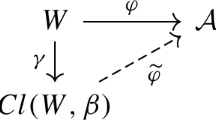Abstract
Spinor spaces can be represented as minimal left ideals of Clifford algebras and they are generated by primitive idempotents. Primitive idempotents of the Clifford algebras R p, q are shown to be products of mutually nonannihilating commuting idempotent % MathType!MTEF!2!1!+-% feaafeart1ev1aaatCvAUfeBSjuyZL2yd9gzLbvyNv2CaerbuLwBLn% hiov2DGi1BTfMBaeXafv3ySLgzGmvETj2BSbqefm0B1jxALjhiov2D% aebbfv3ySLgzGueE0jxyaibaiGc9yrFr0xXdbba91rFfpec8Eeeu0x% Xdbba9frFj0-OqFfea0dXdd9vqaq-JfrVkFHe9pgea0dXdar-Jb9hs% 0dXdbPYxe9vr0-vr0-vqpWqaaeaabaGaaiaacaqabeaadaqaaqGaaO% qaamaaleaaleaacaaIXaaabaGaaGOmaaaaaaa!3DBD!\[{\textstyle{1 \over 2}}\]2}}\](1+e T ), where the k=q−r q−p basis elements e T satisfy e T 2=1. The lattice generated by a set of mutually annihilating primitive idempotents is examined. The final result characterizes all Clifford algebras R p, q with an anti-involution such that each symmetric elements is either a nilpotent or then some right multiple of it is a nonzero symmetric idempotent. This happens when p+q<-3 and (p, q)≠(2, 1).
Similar content being viewed by others
References
Bolinder, E. F.: Unified microwave network theory based on Clifford algebra in Lorentz space, 12th European Microwave Conference Proceedings (Helsinki, 1982), Microwave Exhibitions and Publishers, Turnbridge Wells, 1982, pp. 25–35.
Riesz, M.: Clifford Numbers and Spinors. Lecture Series No. 38, The Institute for Fluid Dynamics and Applied Mathematics, University of Maryland, 1958 (Chapters I–IV).
Hestenes, D., Vectors, spinors, and complex numbers in classical and quantum physics, Amer. J. Phys. 39 (1971), 1013–1027.
Hasiewicz, Z., Kwasniewski, K., and Morawiec, P.: Supersymmetry and Clifford algebras, J. Math. Phys. 25 (1984), 2031–2036.
Coquereaux, R.: Modulo 8 periodicity of real Clifford algebras and particle physics, Phys. Lett. B 115 (1982), 389–395.
Kustaanheimo, P. and Stiefel, E.: Perturbation theory of Kepler motion based on spinor regularization, J. Reine Angew. Math. 218 (1965), 204–219.
Vivarelli, M. D.: Development of spinor descriptions of rotational mechanics from Euler's rigid body displacement theorem, Celestial Mech. 32 (1984), 193–207.
Brackx, F., Delanghe, R. and Sommen, F.: Clifford Analysis, Pitman Books, London, 1982.
Gilbert, R. P. and Buchanan, J. L.: First Order Elliptic Systems, A Function Theoretic Approach, Mathematics in Science and Engineering, Vol. 163. Academic Press, New York, 1983.
Ahlfors, L.: Möbius transformations and Clifford numbers, in I. Chavel and H. M. Farkas (ed.), Differential Geometry and Complex Analysis, dedicated to H. E. Rauch, Springer-Verlag, Berlin, 1985, pp. 65–73.
Fillmore, J. P.: The fifteen-parameter conformal group, Internat. J. Theoret. Phys. 16 (1977), 937–963.
Salingaros, N. A. and Wene, G. P.: The Clifford algebra of differential forms. Acta Applic. Math. 4 (1985), 271–292.
Li, D., Poole, C. P. and Farach, H. A.: A general method of generating and classifying Clifford algebras, J. Math. Phys. 27 (1986), 1173–1180.
Greider, K. R.: A unifying Clifford algebra formalism for relativistic fields, Found. Phys. 14 (1984), 467–506.
Clarkson, E. W.: Clifford algebras in relativistic quantum mechanics and in the gauge theory of electromagnetism, Thesis, Dept. Math., Arizona State Univ., Tempe, AZ, 1985.
Benn, I. M. and Tucker, R. W.: The Dirac equation in exterior form, Commun. Math. Phys. 98 (1985), 53–63.
Chisholm, J. S. R. and Farwell, R. S.: Spin gauge theory of the first generation, Nuovo Cim. 82A (1984), 145–237.
Teitler, S.: The structure of 4-spinors, J. Math. Phys. 7 (1966), 1730–1738.
Porteous, I. R.: Topological Geometry, Van Nostrand-Reinhold, London, 1969, Cambridge University Press, Cambridge, 1981.
Albert, A.: Structure of Algebras, AMS Colloquium Publications Vol. XXIV, New York, 1939.
Jacobson, N.: Structure of Rings, AMS Colloquium Publications Vol. XXXVII, Providence, RI, 1956.
Lambek, J.: Lectures on Rings and Modules, Blaisdell Publishing, Waltham, MA, 1966.
Riesz, M.: Sur certaines notions fondamentales en théorie quantique relativiste, C.R. Dixième Congrès Math. Scandinaves 1946, Jul. Gjellerup Forlag, Copenhagen, 1947, pp. 123–148.
Cartan, E.: Leçons sur la théorie des spineurs, Hermann, Paris, 1938, The Theory of Spinors, M.I.T. Press, Cambridge, MA, 1966.
Chevalley, C.: The Algebraic Theory of Spinors, Columbia University Press, New York, 1954.
Crumeyrolle, A.: Algèbres de Clifford et spineurs, Université Paul Sabatier, Toulouse, 1974.
Osborn, J. M.: Jordan and associative rings with nilpotent and invertible elements, J. Algebra 15 (1970), 301–308.
Wene, G. P.: On a result of Osborn. Proc. Amer. Math. Soc. 69 (1978), 11–15.
Wene, G. P.: Alternative rings whose symmetric elements are nilpotent or a right multiple is a symmetric idempotent. Pacific J. Math. 90 (1980), 483–492.
Author information
Authors and Affiliations
Rights and permissions
About this article
Cite this article
Lounesto, P., Wene, G.P. Idempotent structure of Clifford algebras. Acta Appl Math 9, 165–173 (1987). https://doi.org/10.1007/BF00047537
Received:
Revised:
Issue Date:
DOI: https://doi.org/10.1007/BF00047537



